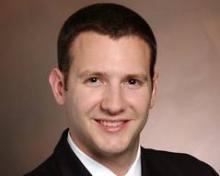SCOTTSDALE, ARIZ. – Although radiation oncologists have typically worried that, in patients with oral cancers, leaving contralateral submandibular glands untreated could lead to tumor involvement of nearby lymph nodes, those worries may soon be put to rest, suggest results of a small retrospective study.
Among 71 patients with locally advanced cancers of the tongue base or tonsils who underwent radiation therapy that avoided targeting the contralateral submandibular glands, there were no cancer recurrences in contralateral level 1B nodes after a median 27.3 months of follow-up, reported Dr. Tyler Robin of the University of Colorado at Denver, Aurora.
"We’re interested in sparing the contralateral submandibular gland because we’re interested in minimizing xerostomia. Xerostomia is a significant morbidity of head and neck cancer radiotherapy, and it has substantial impact on patient quality of life," Dr. Robin said at the Multidisciplinary Head and Neck Cancer Symposium.
Intensity-modulated radiation therapy (IMRT) allows treatment beams to be shaped to avoid the parotid glands with no subsequent increase in regional lymph node failures and preservation of parotid salivary flow. But patient-reported xerostomia and quality-of-life outcomes with parotid-sparing techniques have been mixed, Dr. Robin said.
"Interestingly, an earlier study looking at predictors of xerostomia found that dose to the submandibular gland was a stronger predictor of xerostomia than dose to the parotids, and this may be because of the role of the submandibular gland in unstimulated salivary flow," he said.
The submandibular gland is located near level IB lymph nodes, but the risk of contralateral level IB involvement in oropharyngeal (OP) cancers is low, on the order of 0%-2%. Gland-sparing therapy with IMRT has previously been shown to mitigate xerostomia and to be safe, but primarily in patients with early-stage disease, prompting the investigators to examine whether it would also be safe and effective in patients with locally advanced tumors.
The question is particularly relevant at a time when the epidemiology of OP cancers is shifting toward patients who are positive for the human papillomavirus, who are more likely to have good therapeutic outcomes and who may live for many decades beyond an initial diagnosis, Dr. Robin said at the symposium cosponsored by the American Society for Radiation Oncology and the American Society of Clinical Oncology.
His team reviewed records of 71 patients treated for primary OP cancers at the University of Colorado and at Memorial Sloan-Kettering Cancer Center in New York.
In all, 40 patients had tonsillar cancers, 28 had base-of-tongue lesions, and 3 had cancers involving both sites.
They considered gland-sparing procedures as those in which total doses delivered to the contralateral submandibular gland during bilateral neck radiotherapy were not more than 39 Gy.
Of the 71 patients, 61 (85.9%) had stage IVA disease, 6 (8.5%) had stage III cancers, and 3 (4.2%) had stage IVB disease. The majority of patients had significant nodal involvement, with 46 (64.8%) having stage N2b; 7 (9.9%) N2c; and 3 (4.2%) having staging N3 disease.
The respective mean and median doses to the contralateral glands were 33.04 and 34.21 Gy.
At median follow-up of 27.3 months, there were 12 treatment failures: 1 local, 6 regional, and 5 distant failures. However, there were no cases of disease recurrence in contralateral level IB nodes, the investigators found. There was, however, one documented case of recurrence in contralateral level IIa lymph nodes.
"We believe this is evidence that contralateral submandibular gland sparing can be feasible and safe even in advanced node-positive head and neck cancers, including base- of-tongue lesions," Dr. Robin said,
The data suggest the need for a large prospective trial specifically addressing the safety and efficacy of contralateral submandibular gland-sparing therapy in patients with locally advanced head and neck cancers. Such studies should incorporate existing xerostomia-based quality-of-life assessments and formal sialometry studies, he added.
While the study shows that contralateral submandibular gland sparing is feasible, it raises the question of whether the technique might increase the dose to the muscles of the floor of the mouth, said Dr. Harry Quon of Johns Hopkins University in Baltimore, the invited discussant.
"There is emerging data that our chemoradiation approaches, with long-term follow-up maybe increases [patients’] risk of death, and one hypothesis that has been put forward is chronic aspiration with secondary injury to the lungs," he said.
Radiation injury to the floor-of-mouth muscles appears to be a significant risk factor for aspiration, indicating that future conformal approaches to treating cancers of the tonsils and tongue base should attempt to avoid delivering excessive doses to the midline mucosa, Dr. Quon said.


